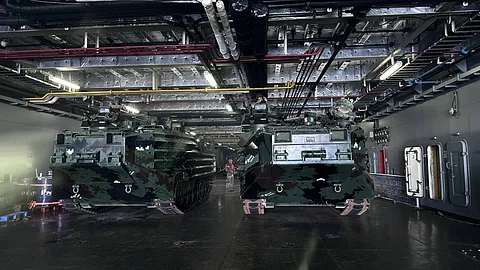
- NEWS
- the EDIT
- COMMENTARY
- BUSINESS
- LIFE
- SHOW
- ACTION
- GLOBAL GOALS
- SNAPS
- DYARYO TIRADA
- MORE

PUERTO PRINCESA CITY, Palawan — Two amphibious assault vehicles from the Armed Forces of the Philippines showcased their land and water capabilities in a demonstration held here.
The vehicles departed on Friday, 3 November, from a landing dock ship anchored in Oyster Bay and made their way to Cabayugan village beach, illustrating their prowess in both combat and humanitarian roles.
Vice Admiral Alberto Carlos, the commander of the Western Command, provided insights into the purpose of these military vehicles. Two out of eight such vehicles in the country are designed for use by marines and amphibious forces and excel in transporting troops and equipment from ships to shore during amphibious operations.
Amphibious assault vehicles are not limited to warfare applications, he said, explaining they are equally valuable in humanitarian assistance and disaster relief efforts.
The operation of these newly-acquired AAVs by the Philippine Marine Corps was coordinated with the 3rd Marine Brigade's Marine Battalion Landing Team-9 and the Philippine Navy's landing dock BRP Davao del Sur.
"They have come together here in the Western Command, and we want to ensure that they can work together seamlessly. The goal is for us to carry out an amphibious operation. It's essential for them to undergo training so that they can understand each other," he explained.
The collaboration is aimed at strengthening the province's defense capabilities and enhancing its capacity to provide crucial assistance during local disaster relief and recovery operations.
During a proficiency landing demonstration and training activity along the shores of Puerto Princesa, Carlos personally observed the interoperability of the units involved. He emphasized the importance of training and coordination for successful amphibious operations, noting the complexity of such endeavors.
"Amphibious operations are highly complex, requiring coordination between the ship and the launching of the AAV. Today, we have seen that they are working effectively and closely with each other, and we're pleased with the results. This is just the beginning of more training activities like this in the Western Command," Carlos remarked.
Before the training activity, Carlos held a briefing session with key military personnel, including Commodore Alan Javier, Commander Marco Sandalo, Colonel Wilfredo Manalang, 1Lt. Carlos Alingcayon, and other officials. This briefing served as an important preparation before the AAVs departed from BRP Davao del Sur for Maratapi Beach in Barangay Cabayugan.
The briefing primarily focused on ship-to-shore deployment procedures for AAVs, emphasizing safety and operational effectiveness. Such operations are integral to amphibious military maneuvers.
The AAVs carried a total of 42 troops and six crew members from MBLT-9, with Vice Admiral Carlos among them, during the ship-to-shore landing, which lasted approximately 25 to 30 minutes. Navigating through challenging surf zones was a critical aspect of the operation.
Upon reaching the designated beach, Marines disembarked from the AAVs, maintaining a disciplined formation as they advanced toward the shore. Naval and air support ensured security against potential threats.
Following the successful landing, troops and equipment swiftly established a beachhead, a crucial phase requiring speed and precision to secure the landing location efficiently.
Colonel Manalang pointed out the exercise's focus on interoperability and readiness for various contingencies, including humanitarian and security aspects.
"This exercise is geared towards interoperability in sustaining our readiness to address any contingencies. Yong mga tropa natin, nagtra-train din sila on different aspects for handling kapag meron tayong HADR and yong mga security elements," Manalang said.
Vice Admiral Carlos noted that having these AAVs in Palawan presents multiple possibilities for their utilization, especially in humanitarian assistance and disaster relief scenarios.
"This versatile equipment allows us to launch operations from the sea, providing us with valuable capabilities in Palawan and the Western Command," he stated.
